Er Hu
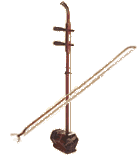
Er Hu is a two-string lute, evolved from Huqin or Xiqin, which appeared in the Song Dynasty, its bow was made of horse tail hair. It was widely used for solo, ensemble and army music from the Yuan Dynasty, and “Huqin”, meaning “barbarian lute” was then a general term for bowing instruments. The word “er” means “two”, “hu” means a “fiddle”, so “Erhu” may mean “a two-string fiddle”; another explanation of the name is that it is second to “Gaohu” in pitch. Whatever the meaning of its name, it is the most popular and mostly used instrument in modern and today’s China in traditional music.
The Structure of Erhu 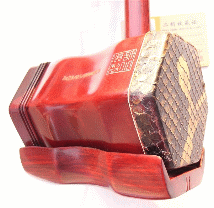
1. Sound Box: As the picture above, it is hexagonal (liu jiao, southern), octagonal (ba jiao, northern), or, less commonly, round. It is usually made of sandle or red wood.
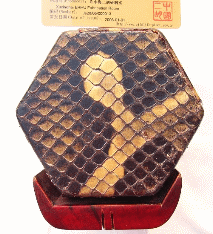
2. skin, made from python. The python skin gives the erhu its characteristic sound. The bigger the scale, the better the sound.
 3. The post that props up the entire structure, usually made of red wood.
3. The post that props up the entire structure, usually made of red wood.
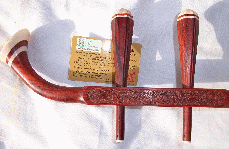 4. Tuning pegs, usually wooden for adjusting pitch sound.
4. Tuning pegs, usually wooden for adjusting pitch sound.
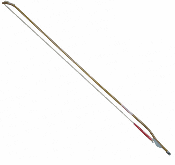 5. bow, has screw device to vary bow hair tension. bow stick, made from bamboo; bow hair, usually white horse tail hair.
5. bow, has screw device to vary bow hair tension. bow stick, made from bamboo; bow hair, usually white horse tail hair.
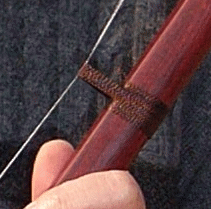 6. Nut, made from string.
6. Nut, made from string.
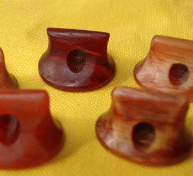 7. Bridge, made from wood.
7. Bridge, made from wood.
The erhu has some unusual features. First is that its characteristic sound is produced through the vibration of the python skin by bowing. Second, there is no fingerboard; the player stops the strings by pressing their fingertips onto the strings without the strings touching the neck. Third, the bow hair is never separated from the strings (which were formerly of twisted silk but today are usually made of metal); it passes between them as opposed to over them (the latter being the case with western bowed stringed instruments). Lastly, although there are two strings, they are very close to each other and the player's left hand in effect plays as if on one string. The inside string (nearest to player) is generally tuned to D4 and the outside string to A4, a fifth higher. The maximum range of the instrument is three and a half octaves, from D4 up to A7, before a stopping finger reaches the part of the string in contact with the bow hair. The usual playing range is about two and a half octaves.
In the 20th century, there have been attempts to standardize and improve the erhu, with the aim of producing a louder and better sounding instrument. One major change was the use of steel strings instead of silk. The move to steel strings was made gradually. By 1950, the thinner A string had been replaced by a violin E string with the thicker D string remaining silk. By 1958, professional players were using purpose made D and A steel erhu strings as standard.
Famous Erhu Pieces:
A notable composer for the erhu was Liu Tianhua (刘天华/劉天華; Liú Tiānhuá) (1895-1932), a Chinese musician who studied Western music as well. He composed 47 exercises and 10 solo pieces (1918-32) which were central to the development of the erhu as a solo instrument. His works for the instrument include 《Yue Ye (月夜; Yuè yè, Moon Night)》 and 《Zhu ying Yao hong (烛影摇红; Zhú yǐng yáo hóng, Shadows of Candles Flickering Red)》.
Other solo pieces include 《Er Quan Ying Yue (1950, Moon Reflected on Second Spring)》 by A Bing, 《Sai Ma (Horse Race)》 by Huang Haihuai, 《Henan Xiaoqu (Henan folk tune)》 by Liu Mingyuan, and 《Sanmenxia Changxiangqu (1961, Sanmen Gorge Rhapsody)》 by Liu Wenjin. Most solo works are commonly performed with yangqin accompaniment, although pieces such as the ten solos by Liu Tianhua and 《Er Quan Ying Yue 》originally did not have accompaniment.
An Erhu instrumental album 《Along the River During the Qingming Festival(清明上河图;Qingming Shanghe tu》 was issued at Nov 22nd 2006,Performed by a famous youth erhu artist Song Fei (宋飞; Song Fei),to express a picture draw in the Song Dynasty by Zhang Zeduan (张择端; Zhang Zeduan),the play was performed by Erhu,Jinghu,Banhu,Gaohu etc. to show the Livelihood,Trade,Festival of the Song Dynasty,the album contains 18 parts.The album represented the greatest achievement of Chinese classical music and it made the China's modern national landmark music works.
